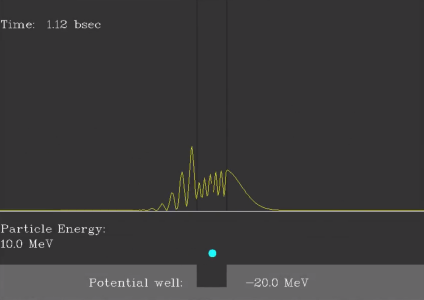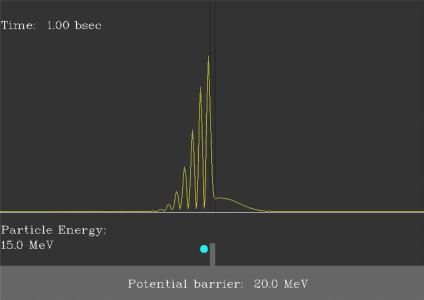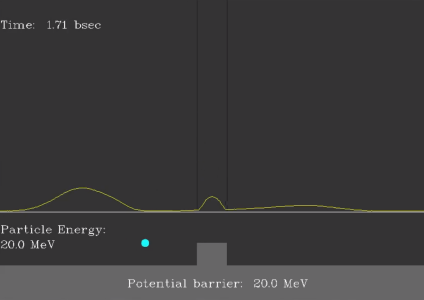Screen Videos with some Striking Examples
 It seems obvious that reflection would occur at a potential barrier.
But you would probably not expect reflection to occur at a potential well.
Strictly speaking, there are even multiple partial reflections, both at the left and at the right boundary of the well.
These partial reflections at the potential boundaries are going on as long as the wave packet is partly trapped
between these boundaries.
The superposition of reflected and non-reflected parts of the wave packet results in
interesting patterns of interference. The distance between two maxima or two minima
is exactly half the wavelength of the wave function.
It seems obvious that reflection would occur at a potential barrier.
But you would probably not expect reflection to occur at a potential well.
Strictly speaking, there are even multiple partial reflections, both at the left and at the right boundary of the well.
These partial reflections at the potential boundaries are going on as long as the wave packet is partly trapped
between these boundaries.
The superposition of reflected and non-reflected parts of the wave packet results in
interesting patterns of interference. The distance between two maxima or two minima
is exactly half the wavelength of the wave function.
 Unthinkable in classical mechanics, but a normal process in quantum mechanics: the passing through a potential barrier.
The wave packet partly penetrates into the potential barrier at the left boundary and
then escapes from the barrier over the right boundary. Again, the patterns of interference
mentioned in the example above show up.
Unthinkable in classical mechanics, but a normal process in quantum mechanics: the passing through a potential barrier.
The wave packet partly penetrates into the potential barrier at the left boundary and
then escapes from the barrier over the right boundary. Again, the patterns of interference
mentioned in the example above show up.
 This effect occurs when the energy of the particle is approximately equal to the height of the potential barrier.
The wave packet is partly trapped between the potential boundaries, moving back and
forth very slowly. Due to partial reflections, it can take quite some time for the wave packet
to disappear from the barrier area.
This effect occurs when the energy of the particle is approximately equal to the height of the potential barrier.
The wave packet is partly trapped between the potential boundaries, moving back and
forth very slowly. Due to partial reflections, it can take quite some time for the wave packet
to disappear from the barrier area.